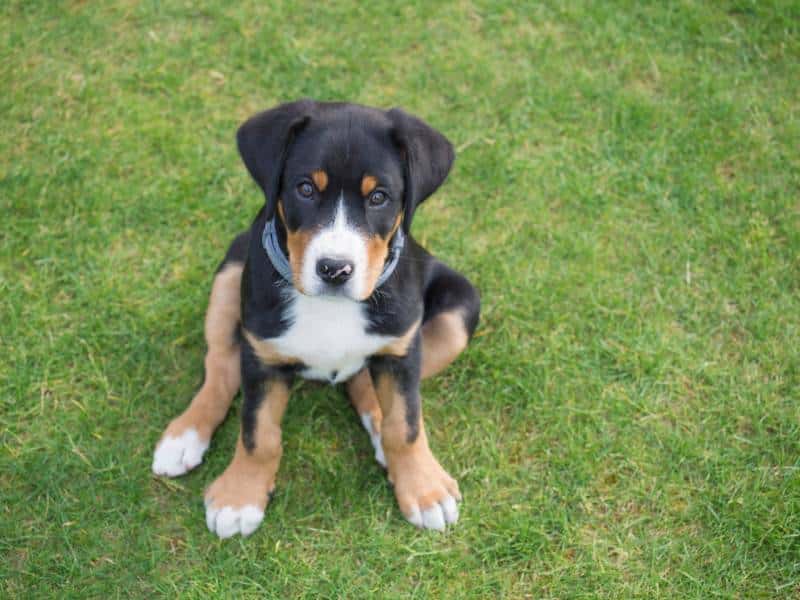We list all the reasons your puppy doesn’t want to walk and the steps you can take to get him moving.

Image Credit: jamenpercy/ Getty Images
Written by: Debbie DeSantis, BAH, CPDT-KA
Last Updated on January 26, 2024 by Dogster Team
Some puppies love to go for walks and will pull ahead like sled dogs to reach their destination. But what if your puppy puts on his brakes and refuses to budge? Don’t despair! Follow our tips to get him happily going.
Walks help exercise a puppy and provide him with socialization to new experiences. But puppies aren’t born knowing how to walk on a leash. So, it’s up to you to train them.
First step: Figure out why your puppy plants his paws.

Top reasons your puppy doesn’t want to walk
Because each puppy is an individual, sift through all these reasons your puppy may be hesitant. And no, they aren’t all behavioral issues.
- Collar or harness issue: The puppy isn’t used to wearing a collar, harness or leash. Some pups freeze in place when any of these are attached until they’ve been trained to wear them. Or, the collar or harness doesn’t fit, which makes walking uncomfortable. Check that the harness doesn’t cover the penis or vagina, which is guaranteed to make your dog not want to walk.
- Not ready to go home. The puppy wants to remain on his walk. He doesn’t want to go home because the walk will end.
- Fear of the great outdoors or new things. Some pups put the brakes on when they’re scared of going outside and all that they will encounter. This includes happily walking during the day, but becoming fearful in the dark at night.
- Too tired to walk. This can occur at the beginning of the walk or sometime during the walk.
- Something is painful. Your puppy may have a physical issue. Or, his nails may be too long, causing discomfort.
- The weather: too hot, cold or rainy.
- Wanting to stop and sniff. A dog has a “nose brain” and loves to see who’s been there and what is going. So, he stops to smell the roses, so to speak.
- Wanting to greet people and dogs. If your puppy is a social butterfly, he’ll stop walking when he sees other beings.
- Wanting to explore. If you always take the same route, a puppy communicates that he wants a new path by refusing to move.
- Too fast or slow pace. If you’re walking too quickly, your pup jams the brakes on because the leash is tight or because he can’t keep up. If you walk too slowly, he’ll stop walking because he’s bored.
- You’ve inadvertently discouraged him to walk. This can happen when someone corrects a dog too often, such as when he pulls or tries to pick up items.

Steps to help your puppy walk on a leash
After you’ve uncovered the reason your puppy isn’t walking, take action. Don’t try to pull your puppy along or tighten the leash — make walking a fun experience! Follow these 13 steps:
- Practice using walking equipment inside your house. Put on his collar or harness and give him yummy pieces of deboned chicken. Play with him. Reward when you attach the leash and allow him to drag it. Encourage him to move forward with a food lure or favorite toy. Make putting on and wearing the equipment a fun game.
- Ensure that your puppy isn’t too tired. Even though the adage that “a tired dog’s a good dog” may be true in some circumstances, it’s not the case here. Choose a time when your pup shows you he’s ready to exercise. Schedule a vet exam to ensure the puppy doesn’t have a physical problem.
- Practice short walks in different weather conditions. Use treats and take him out when it rains. Get him used to warm and cool conditions, too, and wearing a coat or sweater. Avoid temperatures that are too hot or cold, which are unsafe for your puppies.
- Train your pup. Teach core training behaviors, like loose leash walking, Sit, Stay and Come. By teaching these basic cues, you’re training your puppy to move. Training equals confidence.
- Let him sniff. Many dogs enjoy a “sniffari” as part of their walk.
- Praise often and use high-value treats (foods that are a 10 out of 10 for your dog!) when he’s walking, such as small, pea-sized pieces of chicken or cheese. Keep these high-value by saving them only for walking time.
- Appoint your dog’s favorite person or another dog as a lure. Some puppies readily walk when there’s a loved one walking in front of them.
- Plant hidden treasures along the route. A stuffed or favorite toy put in place prior to the walk motivates him to find treasure on subsequent walks.
- Schedule regular walks at the same time of day. Dogs are creatures of habit and respond well to schedules.
- Socialize him using positive reinforcement, introducing him to new scents, sights, sounds, people and animals.
- Start your walk away from home. Carry or drive your puppy a short distance, even 20 feet away. This encourages him to walk homeward bound to his perceived safety.
- Avoid areas that scare him, such as a busy area or road. Instead, find quiet spaces until he’s socialized to new environments.
